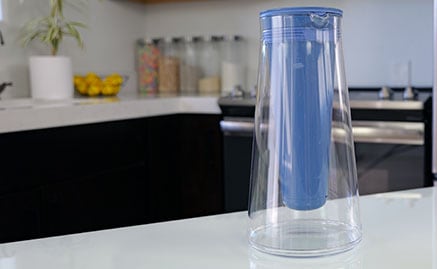
Best For
- Long lasting filer – 264 gallons
- The handle provides excellent stability with a full pitcher of water.
Considerations
- Mediocre purification performance – left a surprisingly high number of contaminants
- Reservoir / Filter housing limits the pitcher to only 10 cups of filter water.
- The carbon filter replacement cap can be slippery to remove.
Our Verdict
The LifeStraw water pitcher is an easy-to-use, quick to setup water pitcher. The clear base easily helps the user visually measure the amount of filtered water in the pitcher. Additionally, the pitcher also is available in a variety of colored models to match your own individual color scheme. Furthermore, the membrane microfilter lasts for 264 gallons or roughly 1 year of use.
While the LifeStraw pitcher is convenient and easy to use, the water lab testing results did show significant concerns. The filter failed to remove uranium, arsenic, lithium, and several other serious contaminants. Unfortunately, this puts the LifeStraw 10-cup water pitcher with one of the worse purification performances we have tested to date.
Type: Pitcher
Capacity: 2.3 L (10-Cup)
Filter Life: Membrane Filter – 264 Gallons, Carbon / Ion Filter – 40 Gallons
In This Review
Purification Performance | Filters | Filtration Speed | Build Quality | Usability | Maintenance | Size | Specs | Product Evolution | Comparison | FAQs
Performance Summary
At Modern Castle we put water filters to the test.
We test 6 different factors that impact the performance, build quality, and usability of the water filter. Below is a complete list of our testing categories and their performance.
| Test Type | Test Data |
|---|---|
| Health Risk Analysis | Low |
| Aesthetic Risk Analysis | Low |
| Filter Quality | Good |
| Filtration Speed | 0.95 cups/min |
| Build Quality | Excellent |
| Filtration Cost | $0.12/gal |
Video Review
Purification Performance
To test water filters, we use a 3rd party laboratory (Simple Lab / Tap Score) to test filtered water. The lab provides a kit to collect water samples for testing. They conduct their analysis and provide detailed reports on the water’s impact on health, aesthetic, and plumbing.
Our review and assessments are based on the laboratory’s findings. For comparison, we also test unfiltered water from our kitchen sink.
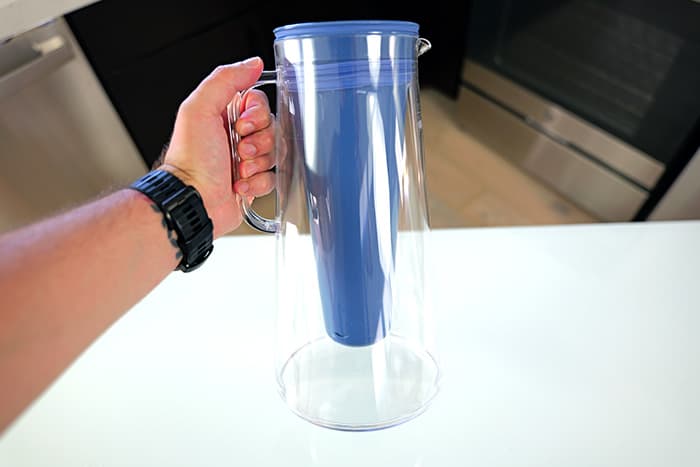
Purification performance was one of the worst scores we have seen to date. The 3rd party laboratory measured unsafe levels of dichloromethane, uranium, lithium, cadmium, and arsenic.
Health Risk
45
Aesthetic Risk
73
Plumbing Risk
69
The comparison of unfiltered water vs. LifeStraw’s results helps us further see purification performance.
| Contaminants | Unfiltered water | LifeStraw 10-Cup | LifeStraw Removed |
|---|---|---|---|
| Dichloromethan | 0.0 ppb | 1.65 ppb | 0% |
| Total THMs | 40.04 ppb | 0.33 ppb | 99% |
| Dibromochloromethane | 9.47 ppb | 0.09 ppb | 99% |
| Bromodichloromethane | 13.12 ppb | 0.12 ppb | 99% |
| Chloroform | 15.94 ppb | 0.0 ppb | 100% |
| Bromoform | 1.51 ppb | 0.12 ppb | 92% |
| Molybdenum | 0.0045 ppm | 0.00404 ppm | 10.2% |
| Uranium | 0.00314 ppm | 0.00272 ppm | 13.3% |
| Nickel | 0.000105 ppm | 0.000103 ppm | 99.9% |
| Chromium | 0.00898 ppm | 0.00105 ppm | 88.3% |
| Selenium | 0.000406 ppm | 0.000406 ppm | 0% |
| Lead | 0.000508 ppm | 0.00 ppm | 100% |
| Copper | 0.581 ppm | 0.0051 ppm | 99.1% |
| Strontium | 0.847 ppm | 0.32 ppm | 62.2% |
| Nitrate | 0.311 ppm | 0.000103 ppm | 99.9% |
| Barium | 0.0865 ppm | 0.0053 ppm | 93.8% |
| Boron | 0.0925 ppm | 0.0053 ppm | 94.2% |
| Zinc | 0.0147 ppm | 0.00 ppm | 100% |
Health Risk Analysis
Clean water is essential to healthy living and preventing the consumption of waterborne contaminants and illnesses. Common health-related issues to unfiltered or contaminated waters are:
- Kidney health
- Liver health
- Developmental outcomes
- Immune systems
- Gastrointestinal systems
- Reproductive systems
- Blood systems
- Nervous systems
- Cardiovascular health
- Skeletal health
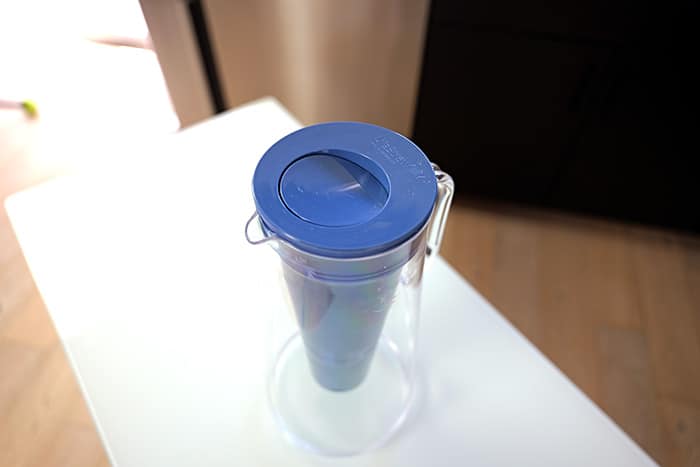

According to the water test that was performed by SimpleLab, the LifeStraw had a high health risk score. Reviewing the testing scores, LifeStraw does remove some harmful contaminants, however, it failed to reduce dichloromethane, uranium, lithium, cadmium, and arsenic to safe levels. . Based on all our laboratory tests to date, the current testing average is 84.7 for Health Risk Analysis, which is 39.7 points higher than the 45 rating the LifeStraw received.

Most notably we saw the LifeStraw add Dichloromethane after water was processed through their filter housing when compared to our unfiltered water sample. According to Simplelab, dichloromethane can be harmful since it is a human-made volatile organic compound. Even so, the results did show that it was below the Federal Maximum Contaminant Level (MCL).

You can view the complete laboratory report and analysis of the unfiltered water here and the LifeStraw Water Pitcher here.
Aesthetic Risk Analysis
Aesthetic is all about how the water tastes and feels. These factors won’t impact your health, but can be important based on personal preference.
The testing results did highlight three areas of concern regarding the aesthetic properties. Sodium, magnesium, and total dissolved solids were identified in the report as the likely sources of taste affecting the water.

However, when compared to our testing report averages, the Lifestraw aesthetic risk analysis is competitive in this score. Sodium was measured at 84.15 ppm, which is 18.59 ppm below the testing average of 102.74 ppm.
Magnesium was measured at 17.46 ppm, which is 4.87 ppm above the testing average of 12.59 ppm. Finally, total dissolved solids were measured at 542.3 ppm, which is 19.27 ppm higher than our testing average of 523.03 ppm.

Plumbing Risk Analysis
Plumbing performance is really a non-factor in our view. Because the water coming from the LifeStraw is not running through the pipes in your home, it will have little to no impact on the condition of the plumbing.
When comparing the plumbing risk against our baseline unfiltered water sample, we saw a minimal difference in corrosivity / scaling and hardness.

The LifeStraw samples showed similar pH levels of 8.19 compared to our baseline sample of 8.22. The pattern repeated for alkalinity at 152.27 ppm compared to 158.31, and CSMR measured at 0.57 compared to 0.57 base sample.
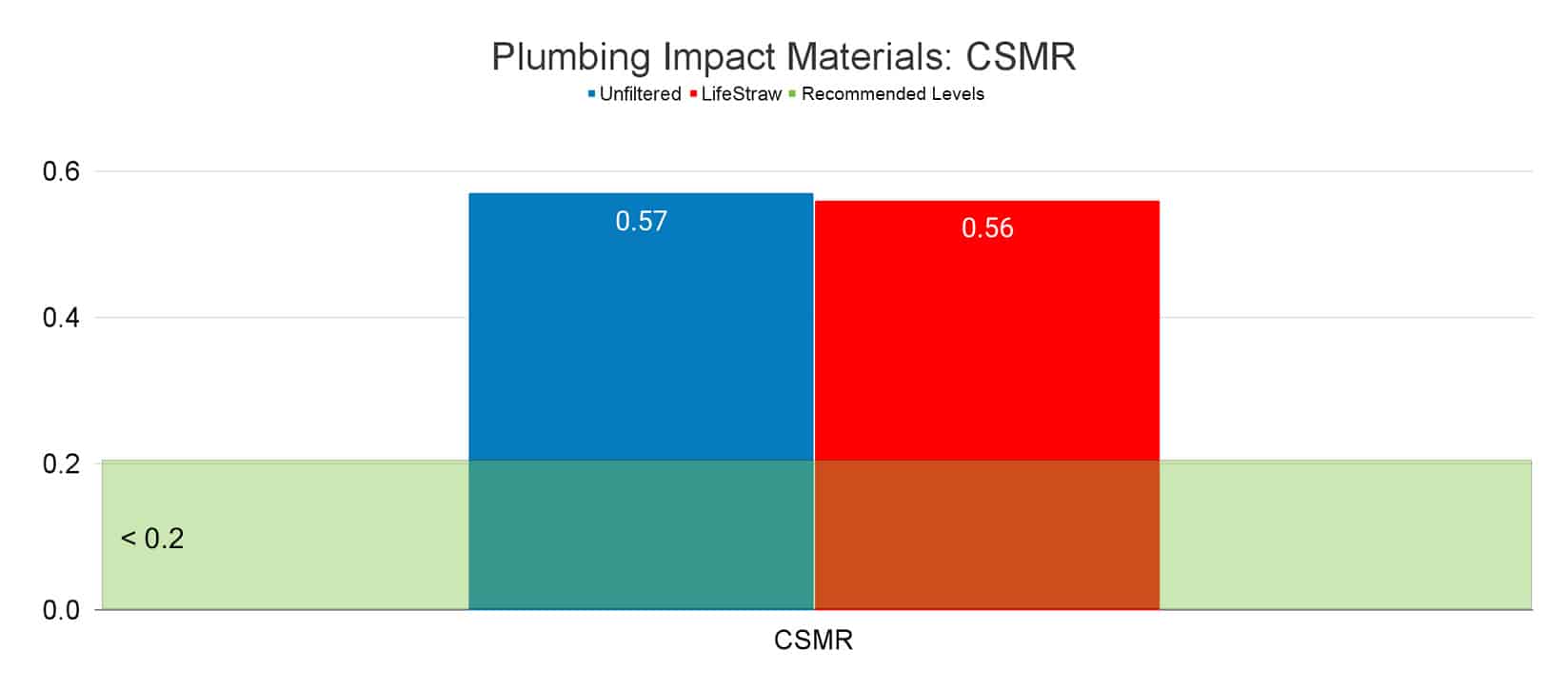
Finally, the results show minimal changes in water hardness when compared to the base sample. The total hardness of the LifeStraw water was measured at 239.29 ppm compared to the base sample at 240.77 ppm. For reference, the current testing average of water filters we have tested is 130.08, which is 109.21 ppm less than the LifeStraw.
Filters
The LifeStraw Home 10-Cup has 3 filters. The first filter is the membrane microfilter. Second is the activated carbon filter. Lastly, is the ion exchange.

Membrane Microfilter – This filter is located inside the main housing of the Lifestraw. It is pre-installed and is the main filter responsible for capturing extremely small contaminants.

Activated Carbon + Ion Exchange – The carbon filter helps remove additional contaminants and metals that pass the microfilter. The Ion Exchange helps soften the water by removing ions from the water and other foreign chemicals.
Filtration Speed
During testing, we observed the LifeStraw Home filter had a moderately fast filter speed. It took roughly 3 minutes and 41 seconds to filter a full reservoir.
LifeStraw Speed
0.95 cups/min
Average Speed
0.92 cups/min
Build Quality Test
Like most water filtration systems, the entire unit is constructed of plastic. Between the base, filter housing, and handle, all were made with plastic. The plastic felt thick and sturdy to handle repeated daily use.
The reservoir lid was conveniently mounted so it would open as soon as the water hit the lid for filling, removing the need to hold / remove the lid to fill. Lastly, the LifeStraw had a large faucet to quickly pour the filtered water out.
| Part | Build Quality |
|---|---|
| Overall | Excellent |
| Pitcher | Excellent |
| Lid | Excellent |
| Filter Container | Excellent |
| Filter | Very Good |
| Faucet | Excellent |
| Water Tank | Excellent |
Usability
The LifeStraw is a convenient water filtration system that allows the user to store up to 10 cups of filtered water. Its simple easy-to-use lid makes filling fast and hands-free
Setup
Setup took about 1 minute to remove from the packaging and get the system read to prime the filters. It is recommended by LifeStraw that you run at least 1 full reservoir through the microfilter, and then again after installing the carbon / ion filter.
On-Going
While testing the system, we noticed that holding and moving the pitcher around was relatively easy with water in the reservoir. In my opinion, this balance is due to the Lifestraw having a good center of gravity with its weight well supported by the handle.
In The Box
- LifeStraw HOME
- Micro Membrane Filter (pre-installed)
- Activated Carbon / Ion Filter
- User Manual / Quick Start Guide
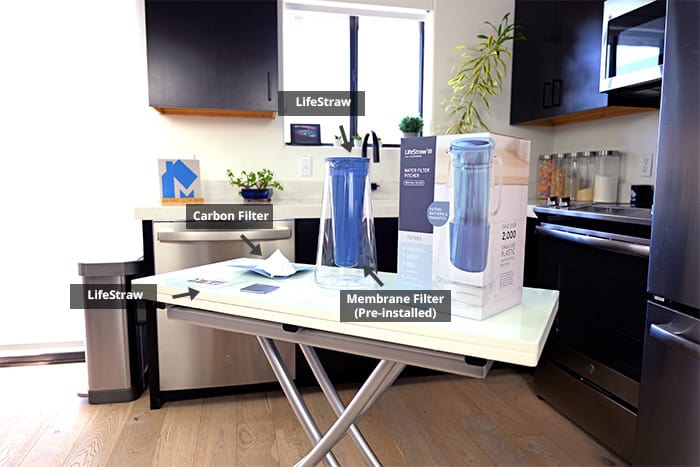
Maintenance
The LifeStraw Home 10-cup has an estimated yearly maintenance cost of $75. The following are the major maintenance tasks for the LifeStraw Home 10-cup. The cost per filtered gallon is estimated to be $0.13 / per gallon (based on consuming 264 gallons per year).
| Task | Description | Est. Annual Cost |
|---|---|---|
| Membrane Filter | Replace every 264 gallons or 1 year | $25 |
| Carbon / Ion Filter | Replace every 40 gallons or 2 months | $50 |
| Water Reservoir | Wash as needed | $0 |
| Water Tank | Wash as needed | $0 |
Size & Dimensions
| Size | Measurement |
|---|---|
| Clean Water Tank Capacity | 10 Cups |
| Water Reservoir Capacity | 3.33 Cups |
| Height | 12.6″ |
| Width | 6.3″ |
| Weight | 1.8 lbs. |
Specifications
The following table details the product specifications according to the manufacturer.
| Specifications | |
|---|---|
| Type | Pitcher |
| Manufacturer | LifeStraw |
| Model | 10 Cup Home |
| Height | 12.6″ |
| Width | 6.3″ |
| Weight | 1.8 lbs. |
| Clean Water Tank Capacity | 10 Cups |
| Water Reservoir Capacity | 3.33 Cups |
| Filters | Carbon, MicroMembrane |
| Warranty | 3 |
| Price | Check Price |
Product Evolution
LifeStraw started making on-the-go filtration solutions for water. Since their initial LifeStraw (the actual straw with a filter built into it), they have ventured into other water filter types.
The LifeStraw Home series has 3 variants. First, the LifeStraw Home, 7-cup plastic.
Then there is another Home 7-cup , but made out of glass instead of plastic. Finally is the model we tested, the Home 10-cup. Each of these models comes in a variety of different filter housing colors for your choice.
How does LifeStraw 10-Cup compare?
Below is a complete list of our water filter tests and critical product data compared side by side to the average based on all of our water filter tests to date.
Table for LifeStraw product data vs. average of product type.
| Test Type | Test Data | Avg. Data |
|---|---|---|
| Health Risk Analysis | 45 | 83.44 |
| Aesthetic Risk Analysis | 73 | 54 |
| Filter Quality | Good | Excellent |
| Filtration Speed | 0.95 cups/min | 0.92 cups/min |
| Build Quality | Excellent | Excellent |
| Filtration Cost | $0.13/gal | |
| Clean Water Tank Capacity | 10 cups | |
| Water Reservoir Capacity | 3.33 cups | |
| Type | Pitcher |
The LifeStraw water pitcher did not have good scores for the filtration performance. It struggled to filter / remove several harmful chemicals that, according to the independent testing lab, repeated consumption could pose serious health risks.
When compared to other water filtration systems we have tested, the LifeStraw water pitcher falls significantly below the performance testing average
Other Water Pitchers to Consider
For Easy Use
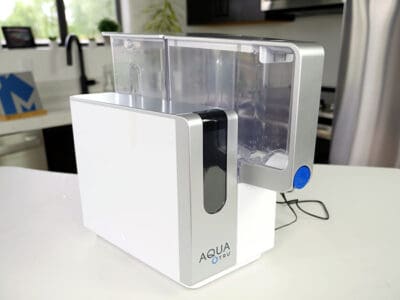
AquaTru Classic RO
The AquaTru Classic is a countertop reverse osmosis system
This RO system is best for being placed on the kitchen countertop for easy access. The system is not refrigerated but allows the user to remove the water reservoir so it can be placed on a fridge shelf.
For Purification Performance
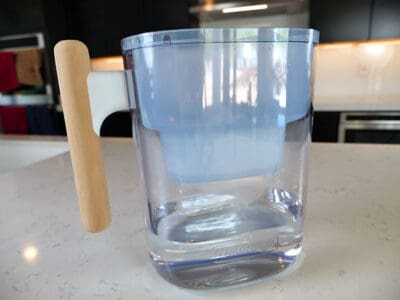
WaterDrop
The Waterdrop is a 10-cup water purification pitcher.
The WaterDrop pitcher is a clear alternative to the LifeStraw. Based on the laboratory data, it’s clear that Waterdrop is the best water filter. It removed 100% of the most dangerous containments in the water, including all uranium and chloroform.
FAQs
According to LifeStraw, their filter will “reduce PFAS and meet the NSF P473 standard for reducing PFOA and PFOS from water”
Lifestraw does claim on its website that it can remove 99.999% of all microplastics. Unfortunately, our independent testing did not test for microplastics to validate that claim.
We highly recommend you do not use river water in any water purification system unless the system is designed for it. Home-based water purification systems are designed to further filter water that has been treated by your local public works department.

